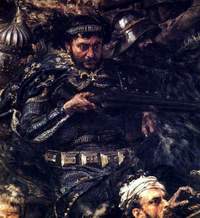
Born: about 1370, Garbow, Poland
Died: 1428, at Golubac (Golebiec), Serbia
Early days. His father was Biernat from Garbow, mother unknown. Why was he called “Black?” This nickname certainly comes from his appearance and not like later believed from a black armor. He was apparently dark haired and had a dark complexion. We had after all in Polish history the kings whose nicknames were based on the color of their hair: Leszek Bialy (White) and Leszek Czarny (Black). The family village, Garbow, is in the vicinity of Sandomierz. The masters of Garbow used the coat of arms Sulima. It was a black eagle with the yellow background and underneath three stones on a red field.
Grunwald. In 1410 he took part in the battle of Grunwald against the Teutonic Order (Krzyzacy) After the battle he proposed a peace treaty between the Polish King Jagiello and the Hungarian King Sigismund of Luxemboug (the 1411 treaty of Lubowla). In 1412 he accompanied King Jagiello to the monarchs’ meeting in Buda (presently part of Budapest, Hungary) where he participated also in a big knight tournament.
Marriage. Zawisza married around 1410 to 1420 Barbara Rozen daughter of Piotr Rozen, coat of arms Gryf. Piotr Rozen built a castle in Roznow and gave it as dowry to Zawisza. In 1414 Zawisza led the Polish delegation to the sobor in Constance.
Tournament in Perpignan. In 1416 he went with Sigismund the King of Germany and Emperor of the Holy Roman Empire to Aragon where he participated in a tournament in Perpignan. He defeated there the famous knight John of Aragon. In 1417 he became the subprefect (starosta) of Kruszwica. In 1419 he went to Sigismund again, as a deputy of King Jagiello, to ask for the hand of Ofka, the widow of Sigismund’s brother Wenceslaus (Waclaw) King of Bohemia. He stayed with Sigismund who was fighting the Husites. After Sigismund’s defeat at Kutna Hora Zawisza was captured by the Czechs but released soon for – possibly – a high ransom. In 1420 he became the subprefect (starosta) of Spisz.
Royal feast in Cracow. In 1423 on occasion of the coronation of Sonka, Jagiello’s fourth wife, Zawisza gives a feast in Cracow for the Kings of Rome, Poland and Denmark (Eric) and for the Masovian and Silesian princes as well as for Louis of Bavaria and others.
Battle of Golubac. He left probably with the King Sigismund to fight the Turks and in 1428 during the battle of Golubac (Golabiec) on the Danube (Serbia) he was captured by the Turks and probably murdered. After his death he was praised by the great Polish 15th century historian, Jan Dlugosz, by the poet and Cannon of Cracow, Adam Swinka and by the King Sigismund of Luxembourg. Zawisza became for many Poles one of the most popular folks heroes thank to his exceptional bravery and proverbial reliability and loyalty. Famous is the Polish saying "Polegaj jak na Zawiszy" (Rely on him like on Zawisza).
This article uses, among others, material from the Wikipedia article "Zawisza Czarny z Garbowa" licensed under the GNU Free Documentation License. :
Wikipedia
Other sources used:
WIEM
Harcerze (in Polish)
Bractwo (in Polish)
Return to home page:
Prominent Poles